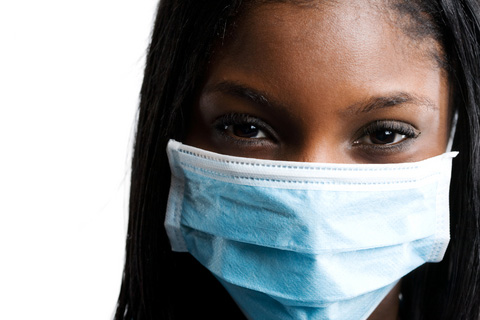Masks Protect Against Colds, Flu

They may look silly but a new study finds surgical masks are your best protection against a cold or the flu.
Donning a face mask — either a surgical mask or a P2/N95 respirator mask (high particulate filter mask) — boosts protection from severe respiratory illnesses such as influenza and SARS, say researchers from the University of New South Wales (UNSW). These masks are not necessarily the same as the dust masks that some people use when cleaning or doing construction work.
In the study, adult mask wearers in the home were four times more likely than non-wearers to be protected against respiratory viruses, including the common cold.
The findings, detailed this week in Emerging Infectious Diseases, the journal of the U.S. Centers for Disease Control and Prevention (CDC), have global implications and are particularly relevant to efforts to combat the spread of flu pandemics and other emerging respiratory diseases such as SARS.
"In the event of a severe pandemic, demand for protection could become a law-and-order issue," said study leader Raina MacIntyre, head of UNSW's School of Public Health and Community Medicine.
"In a crisis, vaccine development is likely to be delayed and drugs may be in short supply or not available at all," MacIntyre said. "Limited supplies will be directed first to front line health workers, so masks are an important means of protection for the community, who otherwise may be last in line for vaccines and drugs."
Good news for parents
Sign up for the Live Science daily newsletter now
Get the world’s most fascinating discoveries delivered straight to your inbox.
While some governments are already stockpiling masks for use in emergencies, MacIntyre said these guidelines had been implemented without evidence to support them.
"We now have provided that evidence," she said. "Masks play an important role in reducing transmission if they are worn properly."
Last year, a CDC study found that wearing face masks and washing hands with alcohol-bases sanitizer cut down flu symptoms in a community by half.
In May 2007, the CDC issued guidelines saying that surgical masks "should be considered" during a flu pandemic for anyone sick with the flu, entering a crowd or living with people with flu symptoms. This wording was a watering-down of a previously considered "face-mask-should-be-worn" recommendation due to a lack of evidence at that time about face masks and the flu.
At a day-to-day level, the study is also good news for parents of toddlers and young children.
"There is no effective treatment for the 90 or so common cold viruses that make families sick each winter, but masks could provide simple and effective protection," MacIntyre said.
But you have to wear it ...
Researchers at UNSW, Sydney's Westmead Hospital, Imperial College (London) and the National Centre for Immunisation Research studied more than 280 adults in 143 families in Sydney during the winter seasons of 2006 and 2007. The adults were randomly allocated masks when exposed to a sick child in the household.
MacIntyre said a drawback was participants' low compliance, with less than half reporting having worn the masks often or always. However, adherence to preventative measures is known to vary depending on perception of risk and would be expected to increase during a pandemic.
The next pressing research question is the value of the use of masks among health care workers. Preliminary work in Australia in 2007 showed very low acceptance of and compliance with mask use by hospital doctors and nurses.
MacIntyre and her team, along with the Beijing Centers for Disease Control and Prevention, are now running a large trial of masks in close to 2,000 health care workers in more than 20 hospitals in China, where compliance with masks is much greater.
"Results from this trial could have wide implications for not only pandemic influenza, but a range of communicable diseases spread within hospitals," MacIntyre said.
- Video – All About the Flu
- The Common Cold: Myths and Facts
- Why Do Doctors Wear Green Or Blue Scrubs?











